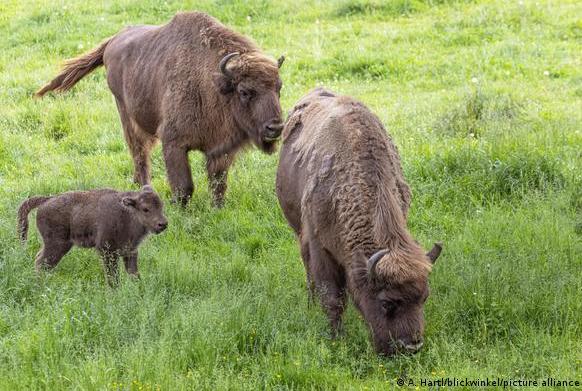
What is rewilding?
“Rewilding” is a term that I have been coming across quite frequently when reading environmental news, and I truly believe we are going to be seeing a lot more of this initiative as we move forward in the climate movement. This is a complex topic that I could write a whole book about, so I took a really high-level approach when explaining this topic. In this post, I explain what rewilding is, success stories, and ways that you can take action by supporting rewilding efforts.
Rewildling explained
Rewilding projects are comprehensive, large-scale conservation efforts that are “focused on restoring sustainable biodiversity and ecosystem health by protecting core wild/wilderness areas, providing connectivity between such areas, and protecting or reintroducing apex predators and highly interactive species (keystone species). The goal of rewilding is to create self-sustaining ecosystems that are dynamic and stable, ideally mirroring diversity conditions pre-human era. This form of conservation combats climate change, protects keystone species, and prevents natural disasters. (rewilding.org)
“Rewilding, in essence, is giving the land back to wildlife, and wildlife back to the land.”
John Davis
There are many environmental benefits to rewilding ecosystems. For example, these strengthened ecosystems protect against climate change impacts like soil erosion and flood risks by stabilizing the land. They also help surrounding communities by creating socio-economic opportunities and reducing the effects and costs that come with environmental hazards like erosion and flooding. (Rewilding.org)
While there are many benefits to rewilding, it does face some issues that stem from a misunderstanding of the rewilding concept. When strategies have inconsistently defined principles, it leads to rewilding efforts and funding to be misrepresented and misapplied. “Misuse of the increasingly popular rewildlng concept risks alienating communities, harming existing biodiversity, and undermining confidence in a technique with enormous conservation potential” (IUCN). Some rewilding efforts are deemed risky in the eyes of many conservationists. This is based on the unpredictability of future weather events, environmental conditions, human actions, etc.

With all that being said, there are a lot of awesome rewilding initiatives happening all over the world that are having positive impacts on the whole ecosystem.
How does it work?
Rewilding is a complex form of conservation and restoration that varies greatly depending on the application method and specific project. However, I am going to share with you the basic shell of rewilding efforts so that you can have a general idea of how they are carried out.
The first step in rewilding is identifying “core “wild” areas, determining what habitats are present, what species are present, and assessing the general health of the ecosystem”. One of the most difficult things to determine is if there is any pollution or toxins present, as well as the history of species on the chosen land. Obviously, the difficulty of any given project increases based on how much human development and impacts are on the land.
Sometimes there are “simple solutions” when it comes to rewilding projects. You can enact legal protections, ban inappropriate animal hunting, and remove barriers in animal corridors like fences, roads, and dams.(Rewilding.org) These are more cost-effective, but unfortunately are not applicable for many of the necessary initiatives needed globally. The most common applications in rewilding are species introduction and corridor creation.
The International Union for Conservation of Nature developed ten principles to guide rewilding initiatives. They did so in consultation with over 150 rewilding experts. They are:
1. Rewilding uses wildlife to restore food webs and food chains.
2. Rewilding plans should identify core rewilded areas, ways to connect them, and ensure outcomes are to the mutual benefit of people and nature.
3. Rewilding requires local engagement and community support.
4. Rewilding focuses on the recovery of ecological processes, interactions and conditions based on similar healthy ecosystems.
5. Rewilding recognizes that ecosystems are dynamic and constantly changing.
6. Rewilding should anticipate the effects of climate change and act as a tool to mitigate its impacts.
7. Rewilding is informed by science and considers local knowledge.
8. Rewilding recognizes the intrinsic value of all species.
9. Rewilding is adaptive and dependent on monitoring and feedback.
10. Rewilding is a paradigm shift in the coexistence of humans and nature.
Rewilding success stories
There are so many successful cases of rewilding all over the world, but I am going to share a few of the largest stories from around the globe. You can find more success stories here!

- The Dutch coast found success in their rewilding efforts, which were focused on bringing back native bison to the region. They began this project in 2007, and now have a healthy population of bison. The grazing of the bison benefits the environment in terms of soil compaction and nutrient dispersal. They are finding the ecosystem to be flourishing with life since this effort!
- One of the most popular cases of rewilding was when wolves were reintroduced to Yellowstone National Park. It was an extremely controversial case between the public, conservationists, and stakeholders based on the benefits and risks of reintroducing a predator to a popular recreational park. It was successful because “eleven packs and 108 wolves are reported as of 2016”. There were no wolves in the park before the reintroudction of 14 Canadaian wolves in 1995, so this growth is great to see.
- The reintroduction of beavers in the UK in 2017 has been a success for the beavers and the environment. The effects of this rewiliding effort so far are improvements to the soil, and flood buffering thanks to the beaver dams! This is a great example of how restored and healthy ecosystems create benefits for everyone: the Earth, wildlife, and humans.
How can you support rewilding efforts?
There are many ways that you can support rewilding efforts on an individual, local, and global scale. If you know of other ways to support rewilding, leave a comment below!

- Large-scale rewilding projects are incredibly expensive, so donating money or volunteering time is one of the most helpful things you can do. re:wild and Mossy Earth are two reputable organizations that are constantly working on rewilding efforts around the globe. Do a quick internet search to see if there are any local rewilding projects in your community that you can volunteer your time or donate money directly to! I personally just discovered Rewild Portland, and I am so excited to start volunteering with them.
- Rewild your own backyard or garden. Encouraging and providing safe environments for native wildlife and insects is so important. It not only helps their populations thrive; it also creates safe corridors for populations to travel through the community with. This is a great article from Mossy Earth on how to get started rewilding your personal outdoor spaces. Even if you live in a rental, you can still have native plants in pots around your property to help create those corridors of safe travel!
- Write a letter to the editor, or contact your local representative to discuss how supporting rewilding could help your community. It is incredibly important to start shifting our mindsets to include ourselves, as humans, into our ecosystems. Having these conversations with others only furthers the discussion!
If you are interesting in learning more about rewilding and would like some help finding resources, reach out to me on the Contact page and I will create a list for you!
References:
https://www.iucn.org/resources/issues-briefs/benefits-and-risks-rewilding
https://rewilding.org/what-is-rewilding/
https://www.cifor.org/publications/pdf_files/Books/CFa1901.pdf


